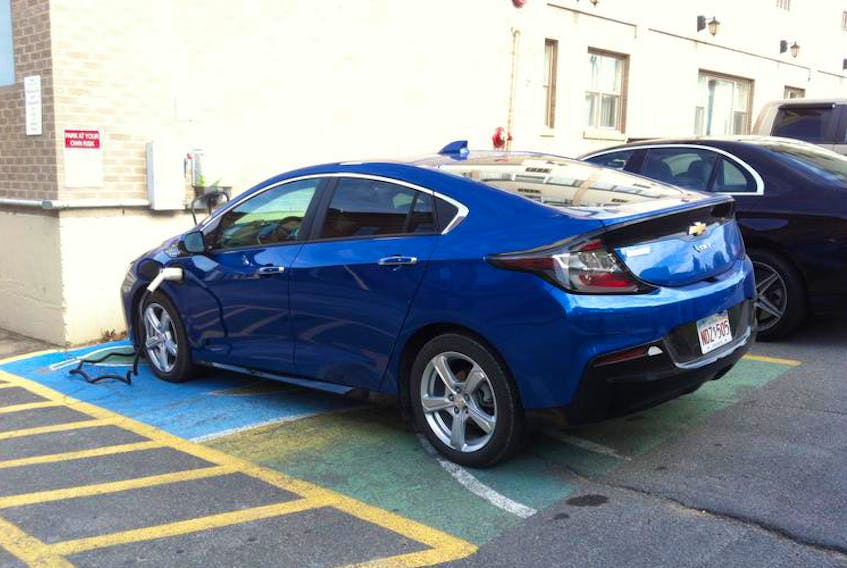I still consider it my ‘new car’ — but already a full year has passed since I bought my Chevy Volt. Here’s an update on the experience so far.Here’s an update on the experience so far.
(A quick note: The Volt is a PHEV, not a full electric. It runs on battery until the battery is empty, and then a gasoline engine kicks in to take over.)
Range
The rated battery range of my PHEV is 85 KM, meaning that’s how far it’s supposed to go in electric mode before the engine starts.
My experience: the battery range dropped last winter, dipping under 60 km on the very coldest days. Significant, but not totally unexpected, for several reasons. First, winter tires reduce efficiency in any vehicle.
Second, performance of any battery drops in cold temperatures. Third, features like interior heating, heated seats and heated steering wheel draw directly from the battery and therefore reduce range.
(I found myself relying mainly on the heated seats for my comfort, using the interior heating mainly to keep the windows defrosted. Plus I preheated the car while it was still plugged in at home to reserve the battery for driving.)
On the other hand, the battery range has routinely exceeded 100 km in the other three seasons. It has even touched 130 km a few times this summer.
The bottom line: on average, my PHEV is easily achieving the promised battery range. Importantly, it has met my key objective, which was that it be able to handle my typical daily commute on battery alone.
It has literally gone weeks without the engine starting. Earlier this summer, I went 5,000 km and nearly two months between gas fillups. I’m 2,000 km into the current tank, and the gas needle has barely budged.
(And — ‘Range anxiety’ — the fear of becoming stranded with a dead battery at the side of the road — has simply not been an issue with my PHEV, because with its backup engine it has a range comparable to any vehicle.
The proof: when I brought it home from Montreal a year ago, I drove over 700 km before stopping for fuel.)
Fuel economy
When running on the gas engine, my PHEV is rated at 5.6 litres per 100 kilometres (50 mpg), and I’ve achieved that on average (like any vehicle, worse in winter and better in summer). By comparison, my previous vehicle, a 2003 Toyota Echo, was rated at 6.2 litres per 100 kilometres (45 mpg) — so it’s already an improvement.
But it’s on battery that my PHEV really shines — rated at 2.2 litres equivalent (Le) per 100 kilometres (128 mpg). That dipped to as low as three Le/100 km (94 mpg) for me last winter, but lately I’ve been getting as high as 1.5 Le/100 km (188 mpg).
The bottom line: over the past year, my spending on gas has dropped by 70 per cent. I’ve spent about $50 at commercial charging stations, and charging the car has added $25-$30 to my monthly power bill. Everything factored in, I’m still well ahead. (And fun fact: many of the dozen public charging stations in my area are free… at least for now).
Plus, it’s worth noting that the main fuel for my car, electricity, fluctuates very little in price. I’ve become pretty oblivious to the weekly seesaw of gas prices.
Other positives
I don’t think I’ll ever tire of how quiet my PHEV is. I won’t tire of its pep either — it’s more powerful than anything I’ve ever owned.
It has great winter traction, thanks to the weight of its battery and its low centre of gravity.
I’ve rarely been out of reach of a charging station, and more are being installed regularly in my area. My PHEV also charges from a standard household outlet, so I’ve not had to do any electrical upgrades. (On the other hand, fully electric vehicles, with their larger batteries, would probably require the installation of a Level 2 charger at their home base.)
It has required zero maintenance except for a single oil change (done under warranty). The odometer is past 50,000 km but my brakes are still like new because of the regenerative braking system, which recharges the battery while slowing the vehicle.
The bottom line
My PHEV was a bit more expensive to buy than a typical car (but less than most trucks or SUVs), but it’s been incredibly cheap to operate so far.
It’s fun, powerful and luxurious.
One year on, I can’t imagine ever going back to gas.
Carl Duivenvoorden (www.changeyourcorner.com; @CDuivenv) is a speaker, writer and sustainability consultant living in Upper Kingsclear, New Brunswick.









